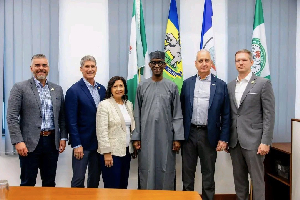Opinions of Monday, 26 May 2025
Columnist: Oluwole Dada, Contributor
The act of creating more leaders and its ripple effect
The most exceptional leaders understand a fundamental truth that their legacy isn't measured by their own achievements alone, but by the leaders they develop and leave behind.
Great leaders create opportunities for their team members to experience what leadership is about. They allow them to function in roles that expose them. They give them tasks that bring out the leadership skills in them.
Transformative leaders push their team members to become better leaders. Genuine leaders recognize that their role includes building the leaders of the future. Leadership should extend far beyond managing current operations. When leaders understand this, it transforms how they approach delegation, development, and succession planning. Rather than hoarding leadership responsibilities, they actively seek opportunities to distribute them, creating what leadership experts call the "multiplication effect."
Jack Welch, former CEO at General Electric, exemplifies this principle magnificently. Welch didn't only run GE, but he also transformed it into what Harvard Business School called "the CEO factory." During his twenty-year leadership, GE became renowned for developing executives who went on to lead major corporations worldwide. Companies like Home Depot, Chrysler, Boeing, and dozens of others recruited former GE executives specifically because of their leadership development.
Other individuals who worked with Jack Welch include Jeffrey Immelt who led GE from 2001 to 2017 and John Krenicki who later became the CEO of GE Transportation. Welch achieved this by systematically creating stretch assignments and leadership opportunities throughout the organization. He established the Crotonville leadership development center, where high-potential employees took on real business challenges while developing their leadership capabilities. More importantly, he personally mentored rising leaders and regularly gave them opportunities to present to the board, lead cross-functional initiatives, and manage significant business units.
Creating leadership opportunities requires intentionality and structure. It's not enough to simply delegate tasks, effective leaders design experiences that specifically develop leadership capabilities. Satya Nadella's transformation of Microsoft illustrates strategic leadership development beautifully.
When he became CEO, Nadella inherited a hierarchical culture where leadership opportunities were tightly controlled. Satya recognized that Microsoft needed more adaptive and innovative leaders across the organization. He systematically created programs to develop them. One of his most successful initiatives involved creating "hackathons" where employees at all levels could propose and lead new projects. These weren't just brainstorming sessions, they were structured experiences where participants had to build teams, manage resources, present to executives, and implement solutions. Many of Microsoft's current senior leaders gained their first significant leadership experience through these programs.
Nadella also established a practice of having different executives lead major company meetings. This approach gave rising leaders exposure to high-stakes situations while developing their communication and strategic thinking skills.
As a leader, you must be prepared to move to the next level of leadership and that is shown by the way you allow your associates to function in your role. When you don't give opportunities to team members to function in higher roles, albeit for a short period, you won't allow them to develop their leadership skills.
Perhaps the most critical aspect of creating leadership opportunities is preparing the organization for future transitions. Leaders who don't develop successors create institutional vulnerability and limit their own advancement opportunities. Tim Cook's development under Steve Jobs and his subsequent approach at Apple demonstrate effective succession planning. Jobs, despite his reputation for control, systematically prepared Cook to lead Apple by giving him increasing responsibility for operations, strategic decisions, and external representation. As CEO, Cook has continued this tradition, creating opportunities for his leadership team to take on greater responsibilities and visibility.
On the flip side, if your leader is giving you opportunities to exercise leadership, make the most of such opportunities and prove to him that you are capable. Never allow such moments to pass without making a loud statement about your readiness to move to the next level. Susan Wojcicki's journey from Google employee to YouTube CEO exemplifies seizing leadership opportunities strategically. When Google acquired YouTube, instead of viewing it as just another assignment, Wojcicki recognized it as a chance to demonstrate leadership capability in a high-growth, high-visibility area. She didn't just manage YouTube's integration, she took ownership of its strategic direction, built new capabilities, advocated for resources, and positioned herself as the face of YouTube's transformation. Her proactive approach to this leadership opportunity ultimately led to her appointment as CEO and established her as one of the most influential executives in the technology industry.
The most enduring leadership legacy is found in the leaders you develop and the opportunities you create for others to grow. By systematically creating leadership experiences, providing visibility and exposure, and having the courage to let others lead, you multiply your impact far beyond what any individual leader could achieve alone. In the words of leadership expert John Maxwell, "A leader is great not because of his power, but because of his ability to empower others." Make empowerment your daily practice, and watch as your leadership ripples outward, creating waves of positive change that extend far beyond your immediate sphere of influence.
Oluwole Dada is the General Manager at SecureID Limited, Africa’s largest smart card manufacturing plant in Lagos, Nigeria.














